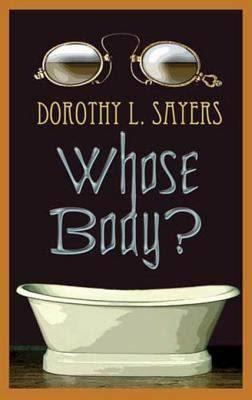8 /10 1 Votes
4/5 ManyBooks Series Lord Peter Wimsey Originally published 1923 Genre Mystery Publisher T. Fisher Unwin | 3.9/5 Goodreads Language English Publication date 1923 Followed by Clouds of Witness Country United Kingdom | |||||||||||||||||||||||||||||||||
 | ||||||||||||||||||||||||||||||||||
Media type Print (Hardcover, Paperback) Similar Lord Peter, Clouds of Witness, Unnatural Death, Strong Poison, The Unpleasantness at the Bell | ||||||||||||||||||||||||||||||||||
Whose body whose body by dorothy sayers unabridged audiobook whodunit detective fiction
Whose Body? is a 1923 novel by Dorothy L. Sayers, which introduced the character of Lord Peter Wimsey.
Contents
- Whose body whose body by dorothy sayers unabridged audiobook whodunit detective fiction
- Plot summary
- Literary significance and criticism
- References
Plot summary
Wimsey's mother, the Dowager Duchess of Denver, telephones to say that Thipps, an architect hired to do some work on her local church, has just found a dead body wearing nothing but a pair of pince-nez in the bath in his London flat. The official investigator, Inspector Sugg, suspects Thipps and his servant; Wimsey starts his own enquiry. Sir Reuben Levy, a famous financier, has disappeared from his own bedroom, and there has been a flurry of trading in some Peruvian oil shares. Inspector Parker, Wimsey's friend, is investigating this.
The corpse in the bath is not Levy, but Wimsey becomes convinced that the two are linked. The trail leads to the teaching hospital near the architect's flat, and to surgeon and neurologist Sir Julian Freke, who is based there. Wimsey discovers that Freke murdered Sir Reuben and staged his 'disappearance' from home, having borne a grudge for years over Lady Levy, who chose to marry Sir Reuben rather than him - a grudge aggravated by Freke's prejudice against Jews. He also engineered the trading in oil shares, to lure Sir Reuben to his death. He dismembered Sir Reuben and gave him to his students to dissect, substituting his body for that of a pauper donated to the hospital for that purpose, who bore a superficial resemblance to Sir Reuben. The pauper's body, washed, shaved and manicured, was then carried over the roofs and dumped in Thipps' bath as a joke. Freke's belief that conscience and guilt are inconvenient physiological aberrations, which may be cut out and discarded, is an explanation for his conduct. He attempts to murder both Parker and Wimsey, and finally tries suicide when his actions are discovered, but is arrested in time.
Literary significance and criticism
"A stunning first novel that disclosed the advent of a new star in the firmament, and one of the first magnitude. The episode of the bum in the bathtub, the character (and the name) of Sir Julian Freke, the detection, and the possibilities in Peter Wimsey are so many signs of genius about to erupt. Peter alone suffers from fatuousness overdone, a period fault that Sayers soon blotted out."
The book establishes many of Wimsey's character traits, such as his interest in rare books, the nervous problems associated with his wartime shell-shock, and his ambiguous feelings about catching criminals for a hobby — and also introduces many characters who recur in later novels, such as Parker, Mervyn Bunter, Sugg, and the Dowager Duchess. There is a passing reference in the book to Freddy Arbuthnot, Wimsey's friend and contact for the stock market, being in love with Sir Reuben Levy's daughter Rachel and wanting to marry her. This is picked up in Strong Poison, which takes place seven years later, in which Freddy at last convinces Rachel's family to consent to the match despite his being a gentile - after Freddy compared his long wait with that of the Biblical Jacob for his Rachel.
The original finding of the naked body and the deductions to be made from it were fairly 'daring' for the time. In the original text, Parker decides that the body in the bath could not be Sir Reuben Levy because "...Sir Reuben is a pious Jew of pious parents, and the chap in the bath obviously isn't..." This backhanded reference to circumcision was felt by Sayers's publisher to be too frank, and in the published version the deduction was made merely on the basis that the dead man appeared to have been doing manual labour rather than living the comfortable life of a wealthy financier.
At the beginning of the story there is a reference to a prior, long-lasting enmity between Wimsey and Inspector Sugg, reminiscent of the relations between Sherlock Holmes and Inspector Lestrade. At the end Wimsey generously allows Sugg to take completely undeserved credit for the solution; the grateful Sugg cannot go on with his hostility to Wimsey. In later books, Sugg fades away and Wimsey's relations with the police become dominated by his amicable partnership with Parker.
Whose Body? is now in the public domain in the United States, but still in copyright in the United Kingdom and the rest of Europe (where the copyright term is 70 years after the author's death).
